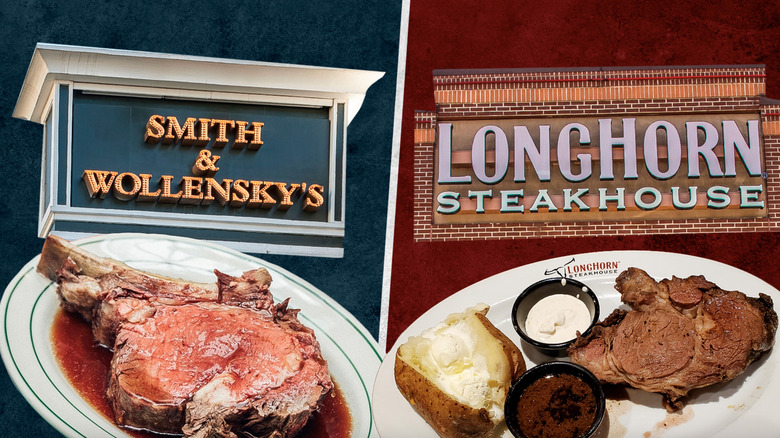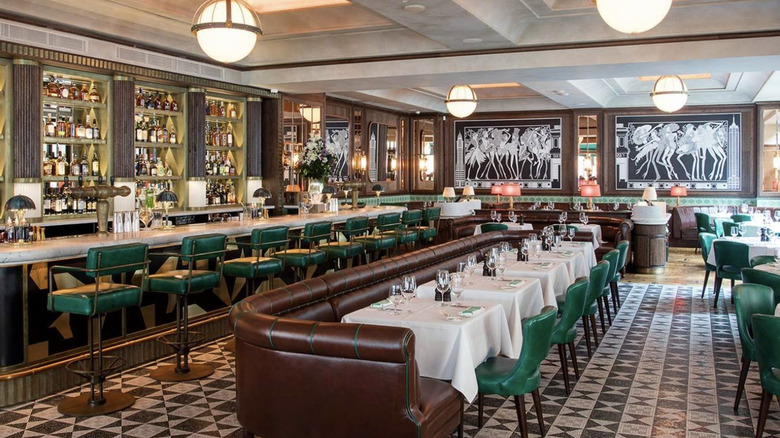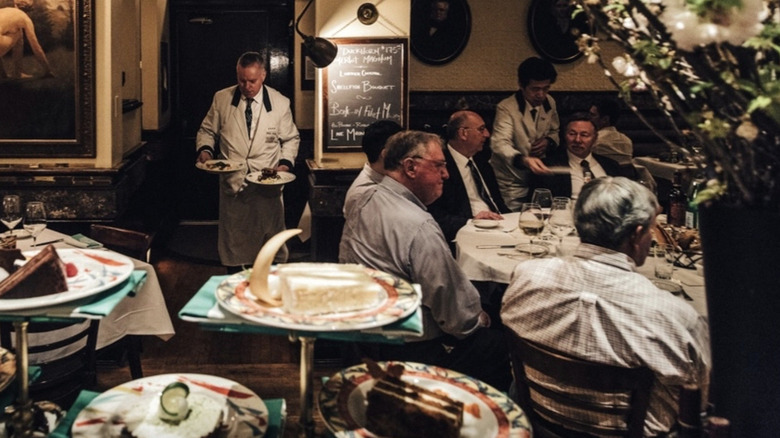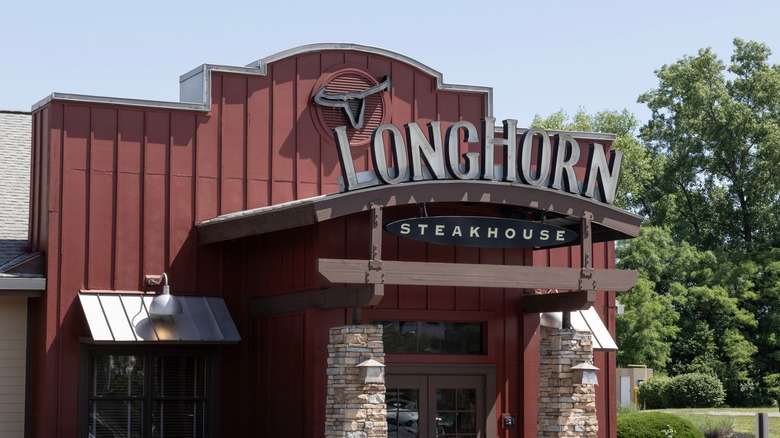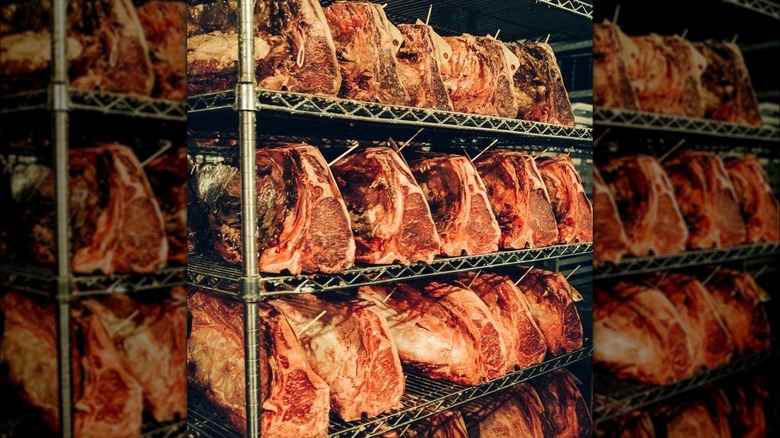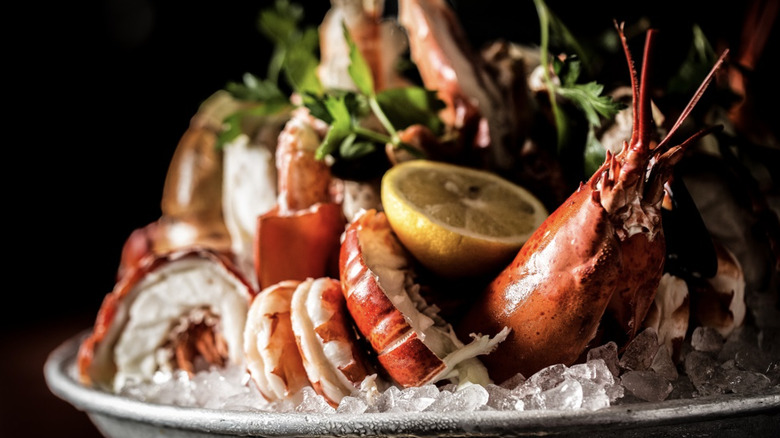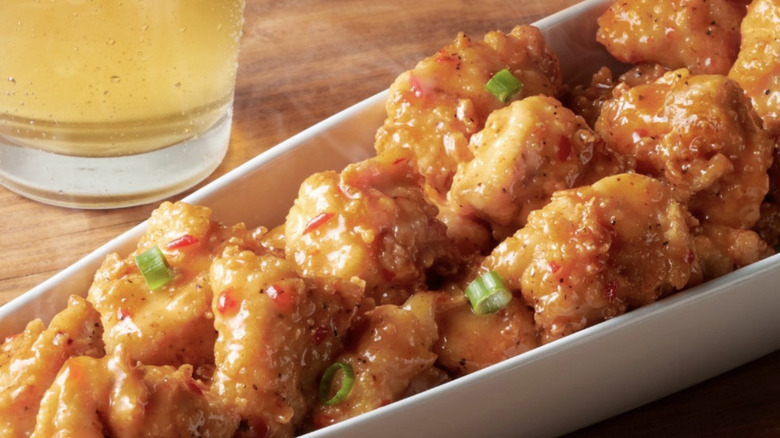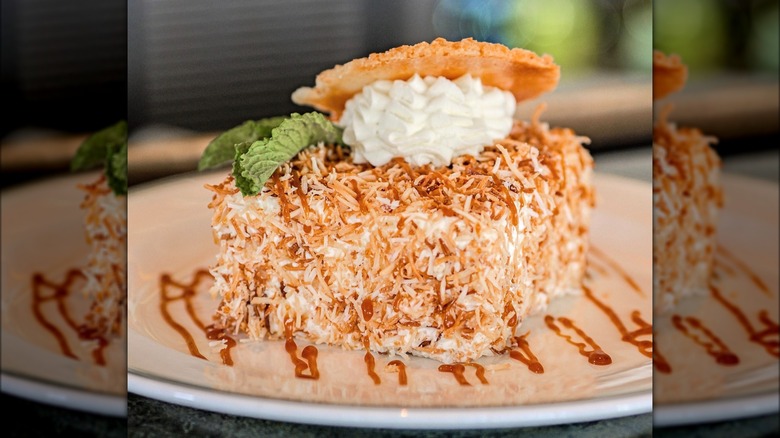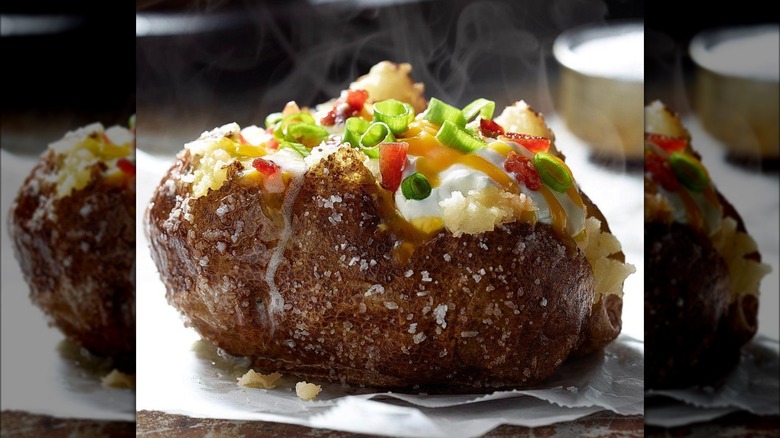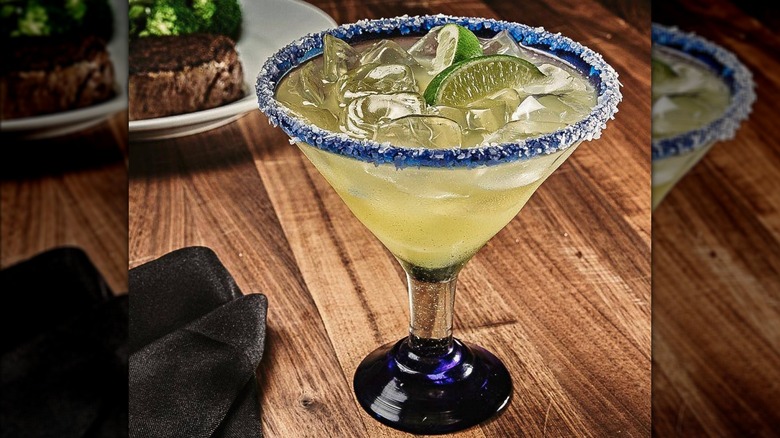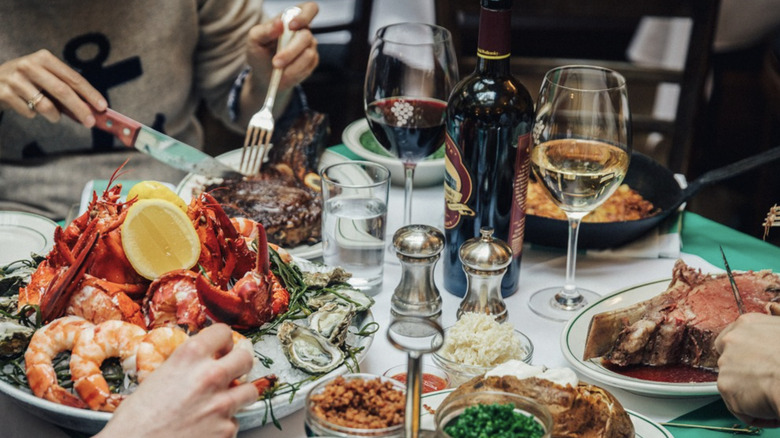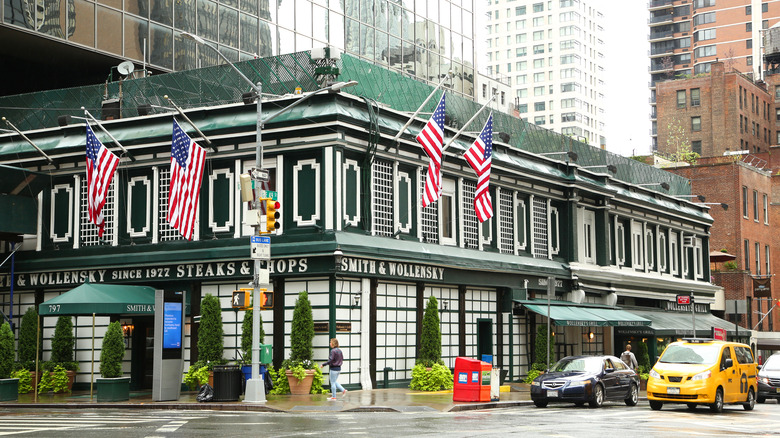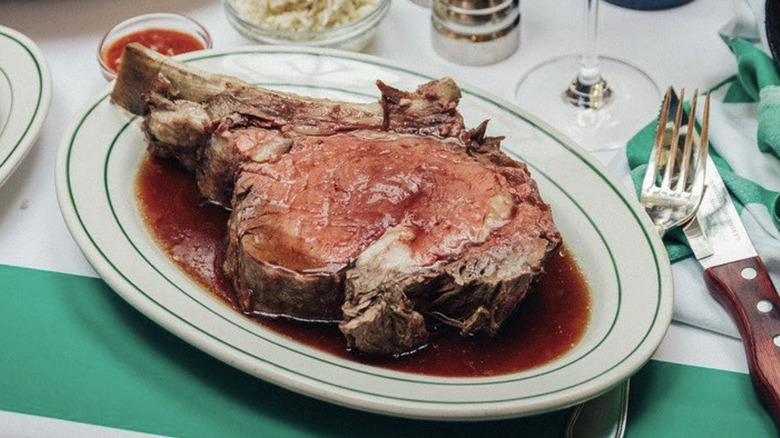LongHorn Steakhouse Vs Smith & Wollensky: Which Is Better?
LongHorn Steakhouse and Smith & Wollensky operate on vastly different scales. While the number of Smith & Wollensky locations can be counted on two hands, LongHorn is a steakhouse giant with hundreds of restaurants. Both chains also have very different atmospheres and target diners. Smith & Wollensky is an elegant restaurant known for its fine dining and top quality beef that caters to an affluent clientele. In contrast, LongHorn Steakhouse is a more casual place that offers a relaxed dining environment that's popular with families and groups looking for a more wallet-friendly meal.
Despite their differences, evaluating LongHorn Steakhouse and Smith & Wollensky against each other hasn't been easy. Nevertheless, to help you find the restaurant that's right for you, we have done our best to compare the two chains across several areas, such as ambiance, menu options, and price points. For more information about our assessment criteria, take a look at the end of this article.
The restaurants have different ambiances
Named after a North American breed of cattle with strikingly long horns, LongHorn Steakhouse screams country. The chain is decorated with Western bric-a-brac and has a more rustic feel, including paintings of cowboys and the American countryside, antler chandeliers, and taxidermied animals. It also features plenty of wooden paneling and exposed bricks. The restaurant's subdued lighting adds a cozy touch to the low-key proceedings. Many LongHorn Steakhouse locations feature both a dining room and a more informal bar area with television screens where diners can enjoy a pre- or post-dinner tipple.
In contrast, Smith & Wollensky is more upscale, featuring classic steakhouse decor. The brand was created by pulling two names at random from a New York City phone book. While no two locations are the same, many of the chain's restaurants boast sophisticated elements such as leather seating, timber paneling, and mosaic marble floors. The refined dining experience is further elevated by the chain's iconic green and white tiling, brass touches, and captivating art works. Many Smith & Wollensky locations feature a separate bar area, multiple floors, and outdoor dining patios.
Smith & Wollensky is more expensive
It goes without saying that a more refined dining experience usually comes at a higher price than a dinner at a casual steakhouse. This also holds true in our comparison, with Smith & Wollensky being pricier than its less formal competitor, LongHorn Steakhouse. While prices may vary by location, here are some examples.
The appetizers at Smith & Wollensky start at $20 for the burrata with basil-cilantro pesto, charred pineapple compote, and crostini and go up to $29 for the crab cake with cognac mustard and ginger sauce. Side dishes at Smith & Wollensky are also much more expensive than those offered by LongHorn, with whipped potatoes priced at $12, french fries at $10, truffle mac & cheese for $20, and asparagus with hollandaise sauce at $15. In comparison, at LongHorn mashed potatoes and French fries cost $3.99. Its Steakhouse mac & cheese and steamed asparagus are $5.49 each.
The entrées at both chains also come with very different price tags. For instance, a 12-ounce New York strip at LongHorn Steakhouse costs $28.99, while an 8-ounce petit New York strip at Smith & Wollensky is priced at $39. Meanwhile, a 20-ounce bone-in ribeye at LongHorn is $38.29, while a 26-ounce bone-in ribeye at Smith & Wollensky is $76. In the seafood department, the Atlantic salmon with a bourbon marinade at LongHorn Steakhouse costs $24.79 while Moroccan salmon with ras el hanout spice and chermoula at Smith & Wollensky will set diners back $44.
LongHorn Steakhouse has more locations
Despite its Texas-inspired theme, LongHorn Steakhouse opened for business in Atlanta, Georgia, in 1981. The restaurant gained popularity after a snowstorm shut down the nearby roads in 1982, leaving hungry commuters with no choice but to sample its offerings. Today, the chain boasts almost 600 locations in the U.S. The states with the greatest number of LongHorn Steakhouses are Florida with 76 locations and Georgia with 71 restaurants. Meanwhile, the cities where the chain has the biggest foothold are Orlando and Jacksonville in Florida. LongHorn Steakhouse also has several locations in Puerto Rico.
Despite the fact that the first Smith & Wollensky restaurant opened in 1977, a few years before LongHorn, it's a much smaller operation. More specifically, the restaurant operates in larger cities that tend to attract travelers from around the world. These include the chain's original location in New York City, as well as seven other U.S. restaurants in Las Vegas, Miami Beach, Boston, and Chicago, among other places. Smith & Wollensky also has outlets in London and Taiwan.
Smith & Wollensky serves higher quality beef
Most beef is commonly classified into three categories, with USDA Prime cuts considered to be of the highest quality. The other two grades are USDA Choice, which is just below USDA Prime, and USDA Select, which is the least desirable of the three because the beef is typically leaner and less flavorful. Smith & Wollensky serves USDA Prime beef, which is known for its abundant marbling. After being dry-aged at 36-degrees Fahrenheit for an estimated four weeks, the beef is hand-trimmed in house to ensure optimal flavor and texture. Aside from USDA Prime, Smith & Wollensky also offers American Wagyu, a cattle breed known for its juicy and rich-flavored beef.
According to LongHorn Steakhouse, the chain's "steaks are always fresh and never frozen, boldly seasoned and expertly grilled." Unfortunately, the restaurant does not disclose what grade of beef it serves. We venture to guess that it's probably not USDA Prime, as inferred by one Quora member who compares the quality of the chain's beef to their best-cooked steaks they make at home. However, what we do know is that LongHorn Steakhouse seasons its beef with a variety of spice blends, including Char Seasoning, Grill Seasoning, and Prairie Dust Seasoning.
Smith & Wollensky features a wider variety of seafood
Aside from serving top quality beef, Smith & Wollensky also specializes in fresh seafood, including fish and shellfish. Just some of the marine delicacies on the chain's menu include East Coast oysters and chilled Maine lobster tail as well as jumbo shrimp, octopus, or crab cocktails. Smith & Wollensky also offers a shellfish tower with seafood options such as jumbo shrimp, lobster, oysters, and scallop ceviche. Smith & Wollensky also has numerous seafood appetizers, including crab cakes, seared scallops, and tuna tartare. Meanwhile, the chain's seafood entrées include nori and gochugaru crusted yellowfin tuna and Moroccan salmon with ras el hanout spice and chermoula.
The seafood offerings at LongHorn Steakhouse aren't quite as varied as those served at Smith & Wollensky. In fact, the LongHorn chain only offers one seafood appetizer — the hand-breaded and fried Wild West Shrimp with spicy cherry peppers and garlic butter. For entrées, LongHorn Steakhouse serves Atlantic salmon marinated in bourbon sauce or Redrock grilled jumbo shrimp skewers with a smoky tomato butter. In addition, the restaurant offers that 7-ounce bourbon-marinated salmon over fresh greens as a salad entrée.
LongHorn Steakhouse serves more traditional starters
LongHorn Steakhouse specializes in hearty American-style dishes, so it's not surprising that this is reflected in its appetizers. The chain serves plenty of chicken options, such as Spicy Chicken Bites in a sweet and spicy chili and ginger sauce, Firecracker Chicken Wraps with cheese, and Seasoned Steakhouse Wings with a smoky Char Seasoning. Some of the restaurant's other starters include the Texas Tonion, composed of onion petals fried a golden brown and tossed in Prairie Dust Seasoning, White Cheddar Stuffed Mushrooms crowned with garlic herb cheese, and Parmesan Crusted Spinach Dip.
As befits its high-end status, Smith & Wollensky serves more upscale appetizers than LongHorn Steakhouse. The chain's seafood options include Angry Shrimp with a lobster butter sauce, Crab Cake with cognac mustard and ginger sauce, and Smoked Salmon Tartare with Hackleback caviar, lemon and herb aioli, and a soft-boiled quail egg. Meanwhile, on the meaty app front, Smith & Wollensky features Tableside Steak Tartare with roasted bone marrow and grilled crostini, American Wagyu Carpaccio with black truffle aioli, and Banh Mi-style Grilled Bacon. Smith & Wollensky offers one starter option for vegetarians — the Burrata with basil-cilantro pesto, charred pineapple compote, and crostini.
The desserts at Smith & Wollensky are more gourmet
The desserts at Smith & Wollensky are worth raving about. Perhaps the most interesting sweet treat on the chain's menu is the Tableside Baked Alaska For Two, which is flambéed right at the table and comes with dulce de leche ice cream and toasted Italian meringue. Chocoholics may wish to opt for the restaurant's 10-layer Gigantic Chocolate Cake topped with Baileys Irish Cream, chocolate mousse, and ganache, or the Warm Skillet Chocolate Chip Cookie with vanilla ice cream. Smith & Wollensky also offers Coconut Crème Cake, New York Style Cheesecake, and Vanilla Bean Crème Brulée.
Not quite as imaginative in its dessert menu options, LongHorn Steakhouse only features four final courses. For chocolate enthusiasts, there's the Chocolate Stampede with six types of chocolate, vanilla bean ice cream, and chocolate sauce, as well as the Molten Lava Cake with a warm fudge center, vanilla bean ice cream, caramel, and chocolate sauce. The other two desserts on the chain's menu include Strawberries & Cream Shortcake and THE Cheesecake crowned with whipped cream, candied pecans, and caramel.
LongHorn Steakhouse is more family-friendly
As a rule of thumb, the more casual a restaurant, the more child-friendly it is. Both LongHorn Steakhouse and Smith & Wollensky conform to this idea. Homely and low-key, LongHorn welcomes children and even features a special menu for diners under 12 years of age. On the less healthy end of the spectrum, children can indulge in the chain's cheeseburger on a lightly toasted bun, macaroni and cheese, or hand-breaded chicken tenders with a honey mustard dip. For more health-conscious youngsters — or their parents — the restaurant also serves child-portioned grilled chicken tenders and a 6-ounce sirloin.
Being more upscale than LongHorn Steakhouse, Smith & Wollensky isn't as accommodating to families, although it does appear that the chain has had a children's menu at least once in the past. However, this doesn't seem to be the case today. In fact, diners don't recommend the restaurant for families, with one Tripadvisor reviewer saying, "No kids menu on their web site. Not really a place for kids — big bar scene, and power scene in dining room." Another patron on Tripadvisor agrees, commenting, "It's not a kids restaurant really. There is an [expected] decorum and there is nothing inexpensive on the menu because it's adult tastes and an adult venue."
LongHorn Steakhouse offers classic sides while Smith & Wollensky features more upscale side options
There's a lot to be said for comfort food. The flavors of familiar dishes can be both satisfying and provide a sense of security only a well-known dish can offer. The side dishes at LongHorn Steakhouse offer exactly this — classic flavors and textures that many of us have enjoyed from childhood. The chain serves different types of starchy sides, including french fries, mashed potatoes, sweet potatoes, and loaded baked potatoes. The restaurant also features its fair share of traditional veggie sides, with corn on the cob, Brussels sprouts, steamed asparagus, and steamed broccoli on the menu.
While many of the sides at Smith & Wollensky are more creative, they are also less familiar. In fact, it appears that the restaurant likes to experiment by combining classic side dishes with modern twists. For instance, the chain serves truffled mac and cheese, asparagus with hollandaise sauce, and cheesy corn manchego. Smith & Wollensky also offers potato rosti, a hash brown-style dish accompanied by horseradish, crème fraiche, and Hackleback caviar, as well as a Charred Cipollini Onion and Peas with lemon butter. For the less adventurous, the chain also has some more familiar sides such as french fries, sautéed mushrooms, and fried onions.
LongHorn Steakhouse serves a range of margaritas
While classic margaritas come with a standard set of ingredients — including tequila, triple sec, and lime — the cocktail is quite versatile. This makes it a favorite among those who enjoy experimenting with their boozy concoctions. LongHorn Steakhouse has taken advantage of this versatility by offering a range of margaritas. And when it comes to flavored variations of the drink, the chain has you covered.
LongHorn's standard house margarita is called Texas. While this concoction doesn't come in a traditional tequila glass, it does feature the cocktail's signature salt rim. More in line with what you would expect a margarita to look like, The Perfect margarita is made with blue agave el Jimador Tequila and is the chain's only margarita poured tableside. True to its name, the visually striking Patrón Dragon Fruit Margarita contains LongHorn Patrón Reposado Tequila, dragon fruit, and pineapple. LongHorn also serves strawberry and mango margaritas made with el Jimador Tequila and either fresh strawberries or mango purée and orange liqueur.
Smith & Wollensky has a more extensive wine list
Comparing the wine offerings at LongHorn Steakhouse and Smith & Wollensky is almost impossible. While Smith & Wollensky offers around 50 different wine options by the glass, LongHorn's selection is much more limited. To put it simply, LongHorn offers seven different wines — three reds and four whites. Within this selection, the chain serves cabernet sauvignon, pinot noir, and merlot for the reds and chardonnay, riesling, moscato, and pinot grigio for the whites. The wines range between $8.79 and $10.29 per pour.
In comparison, Smith & Wollensky features a wider range of reds, whites, and sparkling pours. Its wine list — detailed over 16 pages or more– varies by location. The chain uses the Coravin pour system to extract wine one glass at a time without spoiling entire bottles. It also offers one split, or small 12-ounce bottle, option. Ranging between $14 and $85 per glass, Smith & Wollensky wines come from various regions of California, including Napa Valley, Paso Robles, Oakville, and Sonoma County. The chain also offers plenty of international options from well-known wine-producing countries like France, Italy, New Zealand, and Argentina.
Smith & Wollensky is better overall
While they are both steakhouses, LongHorn Steakhouse and Smith & Wollensky seem like polar opposites. Smith & Wollensky is an upscale mini-chain that specializes in Wagyu and USDA Prime beef, fresh seafood, and imaginative culinary creations that you rarely find at other establishments. Meanwhile, LongHorn Steakhouse is a more casual eatery that serves steaks, a few seafood options, and hearty American-style dishes that are likely more familiar to you.
There's little doubt that deciding between the two chains boils down to personal preference and the specific occasion. Nevertheless, we wouldn't be staying true to our mission if we failed to declare which steakhouse reigns supreme. So, without further ado, we are happy to declare Smith & Wollensky the winner of this steakhouse showdown. While LongHorn Steakhouse is commendable for its commitment to creating an inclusive atmosphere and offering hearty menu options, the chain just doesn't live up to the beef and seafood quality offered by Smith & Wollensky. In addition, the elegant environment and attention to detail make Smith & Wollensky a clear winner when it comes to celebrating special occasions.
Methodology
Pitting two establishments that are so different against each other can be challenging. After all, where do you start when two steakhouse chains offer such contrasting dining experiences? To bring you a comprehensive evaluation of the two restaurants, we looked at a number of factors, including ambiance, menu variety, quality of ingredients, and price points. We also considered additional services such as children's menus and a range of specialized menu offerings.
